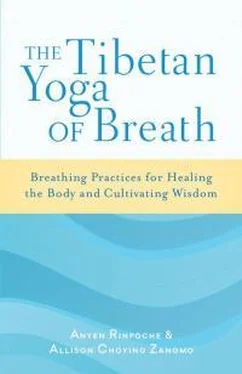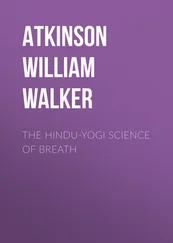HOW BREATH OFFERS PEACE OF MIND
We have shown how breath is the main support for life. We have also explained why training in the breath is the essential method for achieving peace of mind for oneself, which enables us to help and support those around us. Finally, we have said that it is through training in wind energy that we can heal and release all physical and mental suffering completely. Ultimately, this is the experience of wisdom, or realization. It is said in the Buddhist teachings that there is no human being who does not wish for happiness, but among all those beings who are wishing for happiness, it is extremely rare to meet a person who actually knows how to find it. Working with wind energy gives us the opportunity to find authentic happiness day and night.
From the point of view of the Buddhist scriptures, an ordinary healthy being takes about 21,600 breaths in a twenty-four-hour period. Western medicine also says that the average number of breaths per day is around 21,000. 24If we practice mindfulness and appreciate training in the breath, we have an incredible number of opportunities to balance the body and mind every day. When we recognize the opportunity that training in the breath provides, we give ourselves a gift: the opportunity to transcend ordinary suffering.
Working with the breath provides us with a unique opportunity for healing because the breath is something that is with us all the time, every moment. It does not matter whether we are awake or asleep, working or sitting, lying down or doing something active—the opportunity to train in and be mindful of the breath is always with us.
In the Tibetan tradition, not only spiritual realization but other mystical accomplishments such as perpetual youth and extreme longevity arise from training in wind energy. From the point of view of Tibetan Buddhism, if we train diligently in the wind energy until our practice becomes stable and we learn how to calm and purify any agitation that arises, this can lessen symptoms of physical illness, and our lifespan will naturally increase. Also, because we are healthy both inside and out, the color and appearance of our complexion can become youthful and glowing. When we are mentally and emotionally balanced and healthy, it shows.
Usually, when we think about how to make ourselves happy, we seek something on the outside, an external object or event. We look for something that we think will complete us; “If I only had ‘this’ I would feel better.” But when we train in wind energy, we do not need to look for anything outside of us. We do not need to go to the store and buy anything to make ourselves feel less empty, lacking, or unhappy. We do not need to turn on our laptops, televisions, or video games to distract us from how we feel, because we are able to influence our own sense of physical, emotional, and spiritual balance at any moment by working with the breath. The breath is something that is readily available to us simply because we are human beings. We do not need anything else to qualify. How marvelous!
Finding Stability in Wind Energy Training
What does it mean to gain stability in wind energy training? Someone who has achieved stable and balanced wind energy is someone who has a steadfast and even-tempered mental state. Although steady, that person is not stubborn. They are mentally flexible, patient, and not easily disturbed or agitated—like a large body of water without a lot of movement on the surface. Not only would that person’s mental state be pliant and balanced but they would also be calm, relaxed, and healthy.
How many of us can describe ourselves this way? Be honest. We like to project a sense of confidence and well-being to others. And when we perceive others, we have the tendency to think that they are happier, more confident, and less neurotic and agitated than we are. However, when we honestly assess our own state of mind, most of us have the tendency to be emotionally imbalanced in one way or another, whether that tendency manifests as being sharp-tongued and impatient, withdrawn, or generally dissatisfied and skeptical. Whenever the mind is dominated or overwhelmed by a particularly strong pattern of thoughts or emotions, many different kinds of physical and mental sufferings ensue.
For example, some of us experience imbalance as the tendency for worry and anxiety. Our wind energy is so consistently unstable that we have become accustomed to the feeling of instability. The moment we feel calm in the mind, our wind energy immediately becomes unbalanced again and manifests as worry and anxiety. We all know people who have this tendency, or we have this tendency ourselves: it’s as if we simply need something to worry about. We may think to ourselves, “I don’t have any reason to be worried about this,” but we find we are unable to stop. The reason we are unable to stop these mental patterns is that we have become comfortable with, and in some cases addicted to, the feeling of elemental instability, of unstable wind energy. At times, we can feel frightened or hesitant to go beyond our ordinary mode of being.
Why Wind Energy Training Is for Everyone
Based on everything we have learned so far, then, it seems that training in wind energy and attempting to balance the elements within the physical body is not something that only Buddhists should focus on. Western science and Buddhist philosophy agree that calm, relaxed breathing makes us healthier. Because the breath is such an excellent and abundant support for life and vitality for every being on the planet, everyone can benefit from training in the breath, working with the inhalation and exhalation.
THE POSITIVE RESULTS OF PRACTICE
One of the positive effects of wind energy training is that the number of times we need to breathe in one day lessens. We may notice this when we sit down to meditate often and become mindful of the breath; there will be gaps of time where we do not need to breathe. In the case of accomplished or realized practitioners who have trained in any style of breath practice from one of the traditions of Asia, including Qigong, Tai Chi, and Yantra Yoga, the number of breaths taken in one hour can become very few. The result of such practice is clarity and peace of mind, and unshakable physical health. Why is this?
Western medicine answers this question in part by noting that ill people need to breathe more often than healthy ones. 25However, this does not explain why breathing less often also benefits our mental and emotional health. The Tibetan tradition often uses metaphors to explain such complex or intuitive ideas, which can be difficult to understand through more direct means. In this case, if we compare the energy of the physical body to a body of water, then we can access the logic behind this statement.
Each time a gust of wind blows over the ocean, ripples and waves cause movement and agitation on the water’s surface. However, when the air is calm, so is the water. It is just so with the mind. The more often we breathe, the more agitated the energy of body and mind becomes. By breathing less frequently, we begin to achieve elemental harmony. This is exactly how it is, in the case of a great yogi—as the number of breaths in a minute, an hour, a day begins to lessen, the wind energy becomes increasingly stable and balanced. Feelings of extreme mental suffering become less and less over time, so much so that the potential exists for these feelings to completely disappear. This is one way of describing the experience of realization, which will be explored more in later chapters.
Additionally, from the point of view of the Tibetan Buddhist teachings, there are 424 classes of illness that can arise in the body. According to these teachings, because of the lessening of the number of breaths, the wind energy within the body becomes more stable, more even and relaxed, and this releases all classes of illnesses from the physical body as well.
Читать дальше












